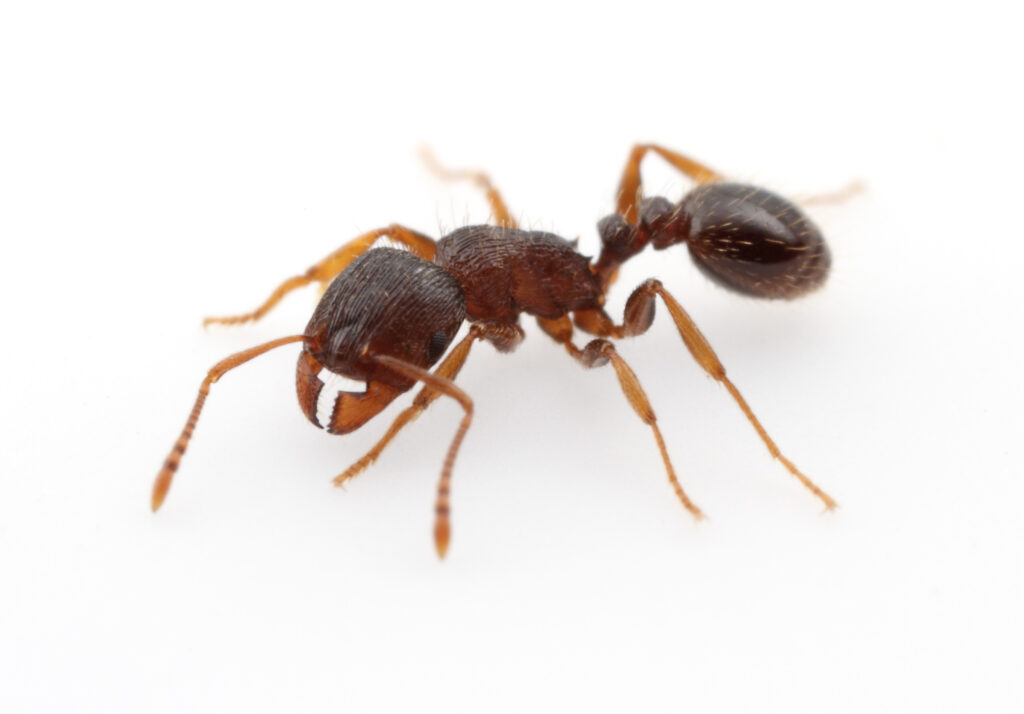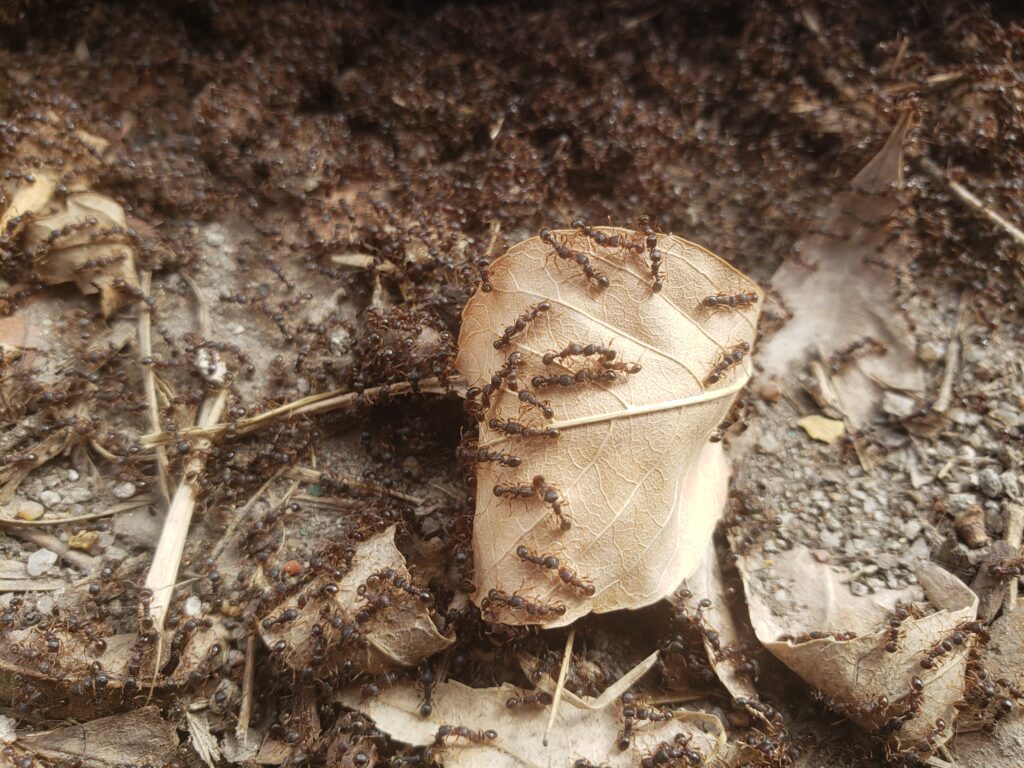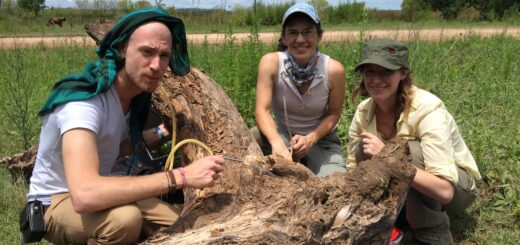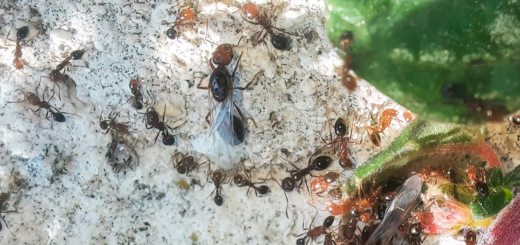They’re not coming out of the walls – Tetramorium immigrans, our innocuous worldwide partner

In the recent review “Always under foot: Tetramorium immigrans (Hymenoptera: Formicidae), a review”, the authors Alexander D. Moss, John G. Swallow, and Michael J. Greene focus on what is known about T. immigrans, a pavement ant, which is native to Europe and invasive to North America. Tetramorium immigrans seems to be a semi-arid open-field specialist and displays quick food-recruitment abilities. Given the current knowledge, its influence on human activity and biodiversity seems small. Here, first author Alexander Moss answers some questions and shares some pictures.
An Interview compiled by Roberta Gibson, Patrick Krapf, and Felix Oberhauser

MNB: Could you tell us a bit about yourself?
AM: At three years old I stood up in preschool and told everybody I wanted to be a paleontologist. I thought dinosaurs were just the best, and the feeling never quite went away: you can still see a Triceratops on my t-shirt. However, as the years wore on I apparently became disillusioned that all my organisms of interest were no longer living and so went to the other end of the animal size scale to study insects. After my undergraduate degree, and a dalliance with video game design, I went into public education. This reinforced to me that I loved teaching, but after some years of junior high, I decided that perhaps I ought to consider educating larger subjects instead.
I’ve since returned to academia and am currently a second-year graduate student in the Greene lab at the University of Colorado, Denver. Our broad area of interest is in the self-organization of ant colonies and how it is accomplished both at a behavioral and neurological level. We use the humble pavement ant, Tetramorium immigrans, as our primary model, and I am particularly interested in the mechanisms and decision making involved in their recruitment and warfare.
MNB: Could you briefly outline the research you published in Myrmecol. News in layman’s terms?
AM: Tetramorium immigrans originated in the Caucasus and spread to different parts of Europe and the Americas, but the timing and pattern of the expansion are unclear. It has large colonies of approximately 10-15k workers – although nobody has ever measured them – all from a single queen, which is unusual for such a tramp species. It has a complex multi-step recruitment process for foraging and a form of (largely) non-lethal warfare that is employed exclusively against conspecifics, neither of which are fully understood. Finally, why exactly it is so successful in urban environments is unresolved, as to whether it is ideally adapted to pavement-with-lawns, is self-compatible at high population densities, has similar food and climate preferences to humans, exhibits particularly efficient foraging, and some other unknown factors, or all of the above.

MNB: What is the take-home message of your work?
AM: That there is a lot of research just waiting to be done on T. immigrans and that much of it is low-hanging fruit simply because of how common it is. It is not hard to locate, acquire, or raise. It conveniently performs much of its behavior against a flat, light backdrop of concrete. Plus, although it seems like a boring ant because it is familiar, in fact with some acquaintance it’s not only fascinating but also rather appreciable as a harmless little buddy species to have around.
MNB: What was your motivation for this study?
AM: I just really wanted to know everything I could about my ant. Near the beginning of my PhD, I was applying for the Tschinkel Grant from the IUSSI and the recommended reading for that proposal strongly impacted my thinking. Namely, they emphasize the importance of basic natural history research as a reference for any theoretical endeavor, and that point struck home to me as I realized that although I was already dreaming of investigating the Big Questions about self-organizational principles I didn’t even know the tiny details about the organism I was using to explore them.
With that, I decided I needed to better equip myself, only to find that the literature itself was a bit of a mess. Because T. immigrans was only delineated as a species recently, most of the research done on it is performed under the heading of T. caespitum, with the result being that it is difficult to disentangle what studies were performed on which species. With my educational habit in hand, I decided that I wanted to write the paper that, had I just joined the lab, somebody would have handed me to explain it all. The result was my review.
MNB: What was the biggest obstacle you had to overcome in this project?
AM: Trying to figure out context for everything I was saying so I could make my paper a story rather than just a heap of facts. While the latter might be a nice bibliography, I really wanted this natural history summary of a single species to have greater relevance through comparisons. For instance, in the early spring, the ratio of alate to worker larvae is 20:1. Is this a high investment in reproductives or normal? I wasn’t quite sure, but I felt that if I wanted to understand what this ant was “about” I needed to know. This required a lot of personal research as I attempted to fill in the gaps in my knowledge so I could offer what I hoped was a coherent explanation for my ant’s natural history strategy and expansion (at one point I found myself researching trade routes from the Balkans to the US in the late 1800s; such is graduate school). What I really hope is that, even if I haven’t gotten the entire story correct, I have still provided a framework to be investigated in future research.
A runner-up obstacle would have to be locating obscure papers. The research I cite is spread out over a century and across the world, and with different people using T. immigrans and related ants for different research projects there was no consistent theme to it. More than once I was saved by machine translation as I ran into papers I could not read but which on transcription revealed to contain key information. Finally, some of the papers were just hard to find and took quite some searching and begging to acquire.

MNB: Do you have any tips for others who are interested in doing related research?
AM: Always find the first source for important details. One of the most consistent themes in writing this review was to how frequently certain papers were relied upon as authorities, only to find that they were only paraphrasing earlier work in a manner that was not always accurate.
MNB: Where do you see the future for this particular field of ant research?
AM: I think T. immigrans lends itself well to research into some of its more interesting behaviors as well as an engagement of the wider public.
As was mentioned above, T. immigrans has an unusual form of warfare. Rather than killing each other, workers from rival colonies lock mandibles in “dyads” across the battlefield, engaging in non-lethal tug-of-wars with each other. These contests can go on for hours, at which point for reasons that remain mysterious, the combatants disperse back to their nests (sometimes to reconvene the next day in the same place and continue). While not the first ant species known to exhibit these sorts of behaviors, they are unusually easy to observe and their interactions involve a great deal of potential information. Do the workers decide they are “winning” based on queuing up, as suggested in other species, or do they gain other information such as the relative pulling strength of their opponent? We know how the levels of some neurotransmitters change in response to interaction, so there is the possibility for manipulative experiments. The rate at which the dyads exchange also seems to vary depending on how many ants there are, and other research has indicated that bursts of recruits come from either side and cause the center of the battle to shift in response. How this resolves into a colony-wide decision is unknown, but several authors note in their observations that species of the T. caespitum complex, of which T. immigrans is a member, are unusually well-organized in their wars with each other and heterospecifics. I think being able to understand why is an exciting future direction of research.
The other main avenue I see for research on T. immigrans is that of citizen science. Already several papers have been published on the species using data collected by students, volunteers, and even school children. It’s everywhere, not hard to collect, and totally harmless. People also find it surprisingly interesting as they’ve seen it but had never given it much thought until they came upon a scientist sucking something up off the pavement and wonder whether they should call the cops. I envision that future studies on its population structure and local preferences will be built on further input from such people and that will help everybody to have some appreciation of this ubiquitous little creature.






It is just the big companion of us, humans, and it rules the world! Great article!